· 14 ·
Benjamin Bass and Boston Sideboards:
A Question of Attribution
MORRISON HECKSCHER
In 1930 and 1931, Fiske Kimball, the legendary architectural historian and museum director, published a series of articles in Antiques on the furniture carvings of Samuel McIntire, a corollary to his principal researches on the Salem architect.1 Kimball began the section on case pieces with the famous demilune commode (fig. 1) that Martha C. Codman had inherited through descent from Elizabeth Derby and given to the Museum of Fine Arts, Boston, in 1923. The attribution of its carving to McIntire, perhaps based more on provenance than style (Elizabeth and Elias Hasket Derby having been leading patrons of McIntire), was not altogether compelling, and Homer Eaton Keyes obliquely questioned it in an editorial in the same issue entitled “A Perplexing Sideboard.”2 The sideboard in question (fig. 2), then the property of Townsend H. Soren of Hartford, Connecticut, shared with the Derby commode a large and distinctive rosette-like carved motif at the top of each leg; the piece bore the pencil inscription “Mary Wood, April 14 1810 Boston, Mass,” which to Keyes suggested its likely date and place of origin. The carvings on the two sideboards, however, were patently the work of different hands.
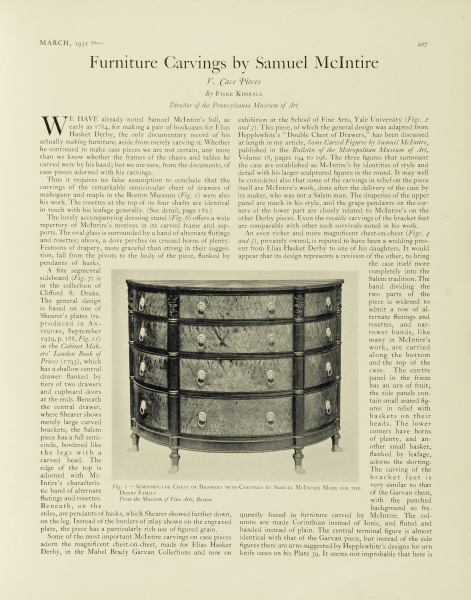
FIG. 1. “Semicircular Chest of Drawers with Carvings by Samuel McIntire. Made for the Derby Family.” From Fiske Kimball, “The Furniture Carvings of Samuel McIntire: Part V, Case Pieces,” Antiques 19, no. 3 (March 1931): 207. Photo, Winterthur Library; Printed Books and Periodicals Collection. See also fig. 16 for a detail of this object.
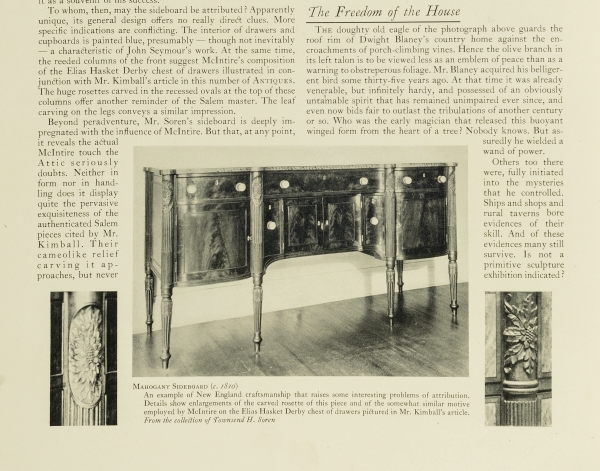
FIG. 2. “Mahogany Sideboard (c. 1810).” From Homer Eaton Keyes, “The Editor’s Attic: A Perplexing Sideboard,” Antiques 19, no. 3 (March 1931): 182. Photo, Winterthur Library; Printed Books and Periodicals Collection. This depicts the Soren family sideboard; see also fig. 8.
In 1937, also in Antiques, Mabel Munson Swan published her revelatory researches on the Boston cabinetmakers John and Thomas Seymour.3 On the basis of a labeled Hepplewhite-style tambour desk—with straight tapered legs, lightwood inlays, and blue-painted interiors—she attributed a superb tambour sideboard (then the property of Andrew Varick Stout; see fig. 9), the Derby commode, and the Soren sideboard to the father and son team. In a concurring brief, Keyes went further, postulating that the Soren sideboard represented a recognizable late Seymour style in the Sheraton manner.4 Ten years later, yet again in the same magazine, the Museum of Fine Arts, Boston, curator Edwin J. Hipkiss published a newly discovered Thomas Seymour bill of 1809 to Mrs. Derby for $295 worth of furniture, of which the most expensive piece, at $80, was the demilune commode.5 Swan’s Seymour attribution was thus confirmed, but to Thomas alone.
One thing none of these publications recorded, however, was that in 1934, three years after Kimball’s article and three years before Swan’s, Kimball came upon what looked to be a virtual mate (fig. 3; see also fig. 7) to the Soren sideboard. Perhaps inspired by Keyes, he attributed it to Boston rather than Salem.6 The recent discovery on this latter piece of the maker’s signature (fig. 4), that of Benjamin Bass Jr. of Boston, is the occasion for this new study.
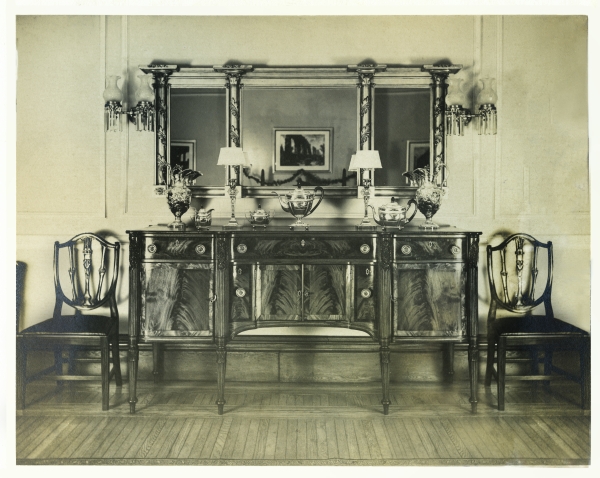
FIG. 3. Photograph of the sideboard in fig. 7 in the dining room of 115 Beacon Street, Boston, 1912–21. Private collection. Photo, Metropolitan Museum of Art.
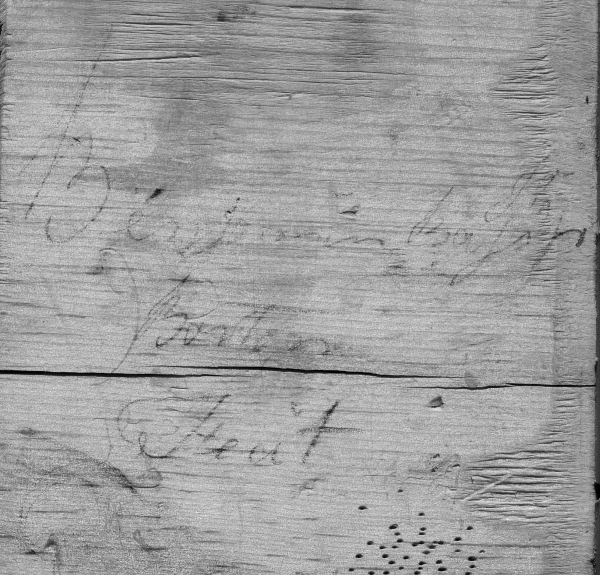
FIG. 4. The inscription on the sideboard in figs. 3 and 7, reading “Benjamin Bass, Jr / Boston / Fecit.” Private collection. Photo, Metropolitan Museum of Art.
PROVENANCE OF THE BASS SIDEBOARD
Family tradition has it that the signed Bass sideboard was originally owned by Benjamin Weld (1758–1839), longtime deputy collector of customs for the city of Boston. A brass plate (probably dating from the early twentieth century) screwed to the inside bottom of the center drawer is engraved “Benjamin and Abigail Weld / Boston / 1793.” Weld married Abigail Perkins (1773–1840) on September 9, 1792, and the 1793 date was presumably chosen on the mistaken assumption that the sideboard had been a wedding present. Datable to about 1810–15, it may have been acquired for the Cambridge Street house where the Welds lived between about 1809 and 1813; it likely also graced their last place of residence in Boston, at the corner of Pearl and High Streets near Fort Hill in the South End (fig. 5).7 Said to have been the largest house in Boston when completed about 1800, it was popularly known as “Harris’ Folly” after its bankrupt builder Jonathan Harris. An 1822 advertisement for its sale at auction describes “that very pleasantly situated and valuable Estate in Pearl Street, lately occupied by Benjamin Weld, Esq. and now by Henderson Inches, Esq. The house contains three parlors on the lower floor, besides a large saloon, or hall, five chambers on the second floor. . . .”8 In 1821, the Welds moved from Boston to Brunswick, Maine, and the sideboard must have been in their house there (179 Park Row, now the Elks Club) until Abigail’s death in 1840.9
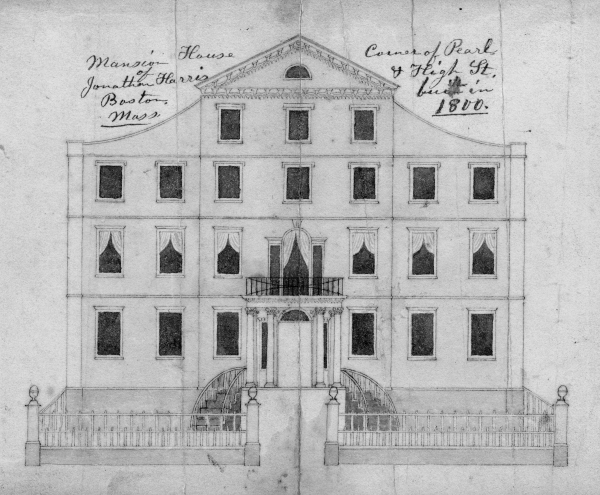
FIG. 5. Drawing of the mansion house of Jonathan Harris, corner of Pearl and High Streets, Boston, ca. 1800 (house completed). Paper, ink, and pencil on laid paper; h 6⅝, w 8⅛. The Bostonian Society (1918.0020.002).
BIOGRAPHY OF BENJAMIN BASS
In the 1970s, in her groundbreaking study of the Boston furniture trade from 1810 to 1835, Page Talbott accurately identified Benjamin Bass as a major, if long-forgotten, player.10 Add to that Robert Mussey’s recent archival researches, and we now know a good deal about him.11 Bass was born in 1775, the son and namesake of Benjamin Bass (1734–1813) of Dorchester, a cordwainer, and Mary Gore (b. 1757) of Roxbury, Massachusetts.12 He is first recorded as a journeyman joiner in the tax records for 1797, at the age of twenty-two. From 1798 until 1801, he boarded over the shop of the currier Stephen Gore, at 12 (the west side of) Orange Street, near the narrowest point on the Boston Neck (fig. 6). We may presume a family relationship between Mary Gore and Stephen Gore, as well as some business relationship between Gore and Benjamin Bass Sr., representing as they do the related shoe and leather trades. But of woodworkers of any sort in Bass’s family circle there is no trace, nor is there any hint of the master with whom Benjamin Jr. must have apprenticed from about 1789 to 1796.
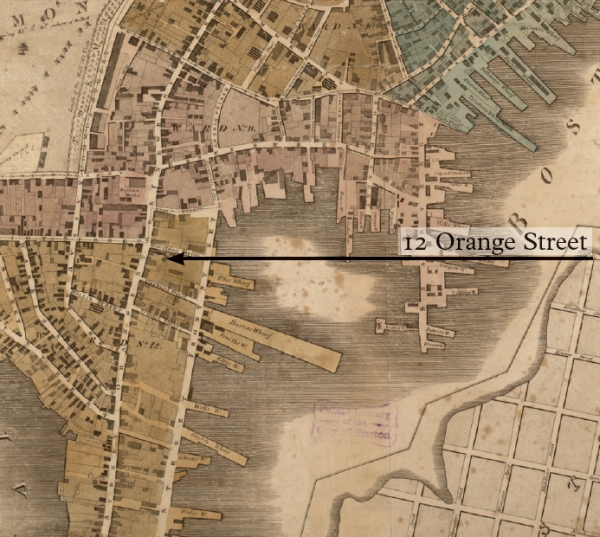
FIG. 6. Detail of Map of Boston in the State of Massachusetts, surveyed by John Groves Hales (1785–1832), engraved by Thomas Wightman Jr. (1782–1820), Boston, 1814. Engraving on laid paper; h 36¼, w 28⅜. The Norman B. Leventhal Map Center at the Boston Public Library. The arrow indicates the area of 12 Orange Street.
In September 1800, Bass offered a reward for an eighteen-year-old runaway “indented Apprentice to the Cabinet Business–named Nath’l Heard.”13 On September 26, 1802, in Brookline, he married Maria White (1782–1815), with whom he would have eight children. That same year, he purchased from Gore the Orange Street building, a property for which he was to be the taxpayer of record until his death in 1819. Those tax records show that between 1800 and 1819, some fifty different journeymen cabinetmakers resided with Bass on Orange Street, all but a handful for a single year each. One of the few who stayed longer was James Barker, a journeyman in 1812 and 1813 and, thereafter, Bass’s business partner.14 Bass advertised twice in the Boston Patriot. The ad of June 19, 1811, described his role as a wholesaler of mahogany—in logs, boards, and veneers—as well as a maker and retailer of a broad range of fashionable mahogany furniture:
MAHOGANY. BENJAMIN BASS, jun. takes this method to inform those Cabinet-makers, who usually supply themselves at this shop, that he has now on hand, for sale, a large assortment of elegant branch and other Mahogany, suitable for Veneres–superior to any he has of late had it in his power to offer.—Also, a general assortment of wide and narrow St. Domingo and Bay Mahogany in boards and planks suitable for use—with about 15 logs of prime St. Domingo Wood, which he will sell by the single log, or cut to any dimensions to suit his customers. The same are at Mr. Glover’s Mill in Dorchester.
On hand, as above, and constantly making, a genteel assortment of fashionable Mahogany Furniture and Chairs entirely of his own manufacture, perhaps as great a variety as is to be found in any one Cabinet Ware Room in town.
Those Ladies and Gentlemen who are furnishing houses, are respectfully invited to call.
The ad of May 18, 1814, announced the “Sale of Furniture, Mahogany and Cotton” by Benjamin Bass and his partner James Barker, including “an extensive assortment of elegant FURNITURE; such as Side Boards, Grecian Card Tables, large Pembroke Tables, with claws. . . .”
Beginning in 1804, Bass’s name appears occasionally in the records of the Suffolk County Court of Common Pleas, either as plaintiff or defendant in monetary disputes. One instance, in 1815, led to the enumeration of an 1814 bill to Boston merchant Elias Burns for $230.50 in furniture, perhaps typical of the firm’s range of objects of middling cost: two sets of chairs (eighteen in all), two bedsteads and a cot, a pair of bureaus, Pembroke table and toilet table, washstand and light stand, and a knife tray.15 Bespoke furniture for the carriage trade is described in the 1813 account of furniture ordered, in anticipation of the wedding of Anna Sophia, daughter of U.S. congressman Elijah Brigham of Westborough, Massachusetts, from various makers, including from Bass a “Sofa easy chair [and] making coverings &c” for $50.16
The senior Bass, listed by the tax man as “shoemaker” or “old gentleman,” resided with his son at 12 Orange Street from 1806 until his death in 1813. This proximity helps explain the consistent use of “Jr.” in all references to the cabinetmaker during those seven years, but rarely otherwise.
Benjamin Sr.’s death coincided with his son’s experimentation with new or different approaches to the business of cabinetmaking, as he shifted his operation from the traditional master-journeyman-apprentice handicraft relationship to a factory model. Between 1812 and 1815, the taxes on 12 Orange Street were paid by an entity called “Benjamin Bass & Co”; beginning in 1814, Bass was in partnership with James Barker—first at their manufactory at 132 Orange Street and then, in 1816, at their “chair Manufactory” on neighboring Front Street. The only documented product of the shop at this time is an unremarkable pillar-and-claw card table from 1816.17
Bass, a member of the Massachusetts Charitable Mechanic Association (established in 1795, with Paul Revere as president) with a few other furnituremakers, including his partner James Barker and Thomas Seymour, was apparently well regarded in his community. However, his ambitious business plans were ultimately unsuccessful. He died intestate, aged forty-four, on August 26, 1819. A petition for administration was filed on August 30 and the inventory on September 27, 1819; the lists of debts and claims, and a representation of insolvency, were filed on June 12, 1820.18 (The estate would not be settled until January 28, 1828.) Meanwhile, a notice in the Columbian Centinel for October 2, 1819, advertising the upcoming sale of Bass’s property on October 11, praised his products as “Elegant Cabinet Furniture and Chairs, made by the first workmen, of the best stock, and of the newest fashions” and concluded that “this is probably the best collection of Mahogany Furniture ever offered at auction in this town.”
The 1819 inventory of Bass’s estate is a fascinating window on the cabinetmaking world of the time. It lists hundreds of pieces of furniture, thousands of unassembled furniture components (mostly for chairs), and stockpiles of lumber, together with five work benches and quantities of woodworking tools.19 Appraised at $9,464 (plus $2,773 in real estate), the amount realized was not enough to offset his debts of $11,886. Among his numerous creditors were prominent members of the furnituremaking trades, including cabinetmakers Emmons & Archbald ($19.28) and Isaac Vose ($125.99), looking-glass maker John Doggett & Co. ($26.50), and carver Thomas Wightman ($26); his debtors included cabinetmakers Levi Ruggles ($79), Lemuel Churchill ($42), and William Fisk ($453), and chairmakers Henry Hancock and Isaac Otis ($35.50).20 (Hancock would take over Bass’s Orange Street premises in 1820.) The great majority of the pieces enumerated were inexpensive tables, stands, and chairs. The chair manufactory specialized in bamboo, fancy, and tablet models. Only a few entries, at the beginning of the inventory, were for costly, presumably bespoke, pieces. Among the latter were two sideboards, one valued at $38, the other at $45, and one “Grand Side Board,” at $100 the most expensive piece in the inventory.
THE BASS SIDEBOARD
“Grand Side Board”—what a fitting description of the sideboard (fig. 7) that bears the pencil inscription “Benjamin Bass, Jr / Boston / Fecit” on the underside of the bottom board of the left-hand drawer. It is large and four-square; its carcass, clad in mahogany and mahogany veneer, is supported on six legs, each turned and reeded and with an acanthus-leaf carved “capital.” Each leg extends up the outside of the case as an engaged colonnette to a distinctive carved motif within a recessed oval—at first glance suggestive of a “squeezed” sunflower but in fact more like a cluster of seed pods surrounded by water leaves.21 The four front legs divide the facade into three bays: a broad concave center and two narrow convex sides. Each bay has two tiers, the upper one for the drawer, the lower for cabinet doors and bottle drawers. All the doors and drawers are veneered with sheets of richly figured mahogany and surrounded by cross-banded mahogany veneers and cock-beaded outer edges; each has a lock and ivory keyhole insert (the latter now obscured by brass escutcheons).22 The circular, stamped-brass, lion’s-head drawer pulls bear the initials “HJ,” the mark of Thomas Hands and William Jenkins (act. 1791–1805) of Birmingham, England.23 The top board has ovolo-molded front and side edges; the bottom skirt is outlined with single and triple applied beading. On each side, crossbanded veneers and beading mimic a drawer front. Overall, the sideboard has a sense of equilibrium, of classical repose, the result of a symmetrical and carefully disciplined arrangement of units: the central bay is exactly twice the width of the side ones; the upper drawers are the same height as the bottle drawers are wide; and the height of the square side cabinet doors is the same as that of the legs.
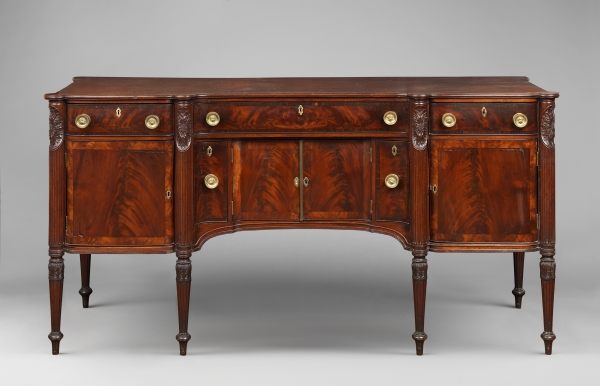
FIG. 7. Sideboard, Benjamin Bass Jr. (1775–1819), Boston, 1810–15. Mahogany, mahogany veneers, white pine; h 41, w 79, d 25¾. Private collection. Photo, Metropolitan Museum of Art.
Bass’s claim to authorship of the sideboard, including in his inscription the Latin “Fecit” for “made it,” is unambiguous. Circumstantial evidence points to its manufacture sometime between 1810 and 1815: Bass used the “Jr.” appellation almost exclusively between 1806 and 1813; his June 1811 advertisement of “elegant branch and other Mahogany, suitable for Veneres—superior to any he has of late had,” perfectly describes the crotch mahogany veneers used on the sideboard’s doors and drawers; and the virtually identical Soren sideboard bears the date 1810 (fig. 8).
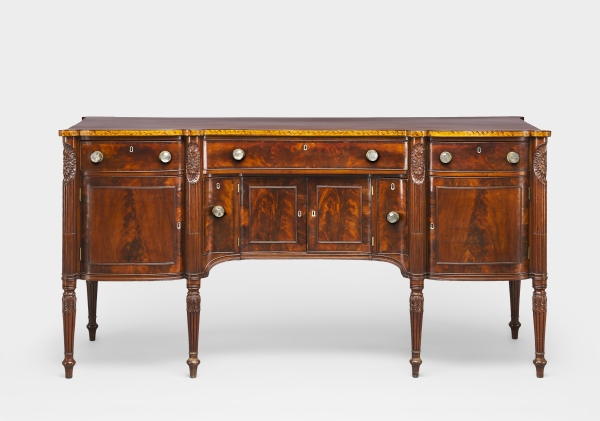
FIG. 8. Sideboard, attributed to the shop of Benjamin Bass Jr., Boston, 1810–15. Mahogany, mahogany and light-wood veneers and inlay, white pine, maple; h 41⅛, w 79, d 26⅝. Baltimore Museum of Art; Gift of Joseph Hennage; Gift of Mrs. Henry Homlet; Bequest of Eleanor M. Lehr; Bequest of Robert Tucker; Bequest of William A. Tuerke, Sr.; Bequest of Lucy Ridgely Seymer, by exchange (1974.6).
A Question of Attribution
How does one reconcile this picture of Benjamin Bass as master craftsman and maker of a “Grand Side Board” with the picture of a man who owned and operated a shop with a constantly changing mix of journeyman cabinetmakers, who engaged in wide-ranging business transactions with many of Boston’s other leading cabinetmaking firms or individuals (even supplying his competitors with mahogany), and who, as time went on, invested in large-scale manufacturing? One does so by acknowledging the complexity of the early nineteenth-century furniture trade and the increased specialization and division of labor in the workshop. When Bass claimed authorship for his sideboard, it didn’t mean that he cut the dovetails of the drawer sides, veneered their fronts, or turned and carved the legs. These tasks were done by his journeyman cabinetmakers or farmed out to specialists, complicating attempts to identify a single “maker.” What Bass can be credited with is the design and the superior quality of execution. That said, what other Boston sideboards can we associate with him?
Sideboards in the Bass Manner
First, the Soren example (see fig. 8), originally published by Homer Keyes back in 1931. In overall design and dimensions, it virtually duplicates the one signed by Bass. It differs only in limited and specific details: in overall size and shape, it is about an inch deeper, its side drawers having more gently curved fronts; the front edge of its top is veneered with a lightwood inlay pattern suggestive of a sort of continuous wave pattern;24 the upper and lower drawer pulls in its center section are not aligned; the engaged upper sections of its legs are stop fluted; and the junctures of the figured veneer panels with the surrounding crossbanding are accentuated with strips of applied beading. In matters of construction, there are notable differences in how drawers and other elements are fabricated and finished. Most striking, the interiors of the Soren sideboard are painted blue, whereas those of the Bass sideboard are clear varnished (both treatments apparently original). It is not hard to imagine that, with new journeymen cabinetmakers arriving all the time in Bass’s shop, considerable variety in construction techniques would have been employed. Was it perhaps a graduate of the Seymour shop who made the inlaid top edge and painted the interiors blue, features associated with that atelier?
Several sideboards closely related in design to the Bass and Soren examples (though none with their tall bottle drawers) seem to share a common aesthetic and may be the product of the same shop.25 All are variations on a theme: on some, the side bays are convex or flat, and the center bays have two tiers of drawers or one drawer over two cupboard doors.26 A serpentine-front sideboard with light-wood inlays and tambour doors at the Peabody Essex Museum has the distinctive carved oval rosettes atop its legs and may be a precursor to the group. Massive examples with panel-framed cupboard doors and legs without carving may represent a later version.27
Among Boston’s myriad early nineteenth-century cabinet shops, only a handful can now be identified as capable of high-end work on par with the Bass sideboard. They include Vose and Coates (act. 1805–19), later named Isaac Vose & Son (act. 1819–23), on Washington Street, and Thomas Emmons and George Archbald (act. 1813–25) nearby at 39 Orange Street (renamed as part of Washington Street in 1824), for whom a number of documented pieces are known (mostly card tables and pier tables).28 Both Emmons and the senior Vose were creditors to Bass’s estate, suggesting past working relationships. Then, of course, there was Thomas Seymour, who opened his commission-based Boston Furniture Warehouse on Common Street in 1804, followed by his Boston Cabinet Manufactory on Congress Street in 1812. For sale at the latter location was “Useful, and Ornamental Cabinet Furniture all made by or under the direction of Thomas Seymour.” Although we know of no direct business connection between Seymour and Bass, in 1817 the latter’s partner James Barker advertised “a good assortment of Cabinet Furniture and Chairs, some of new patterns. The work is, made of the best wood and Mr. [Thomas] Seymour’s whole attention is in the manufactory.”29
Let us now compare the Stout sideboard (fig. 9), first ascribed to Thomas Seymour by Mabel Swan in 1937, and presumably a supreme product of his Boston Cabinet Manufactory, with the one by Bass (see fig. 7). The overall design is the same, but the execution—the aesthetic—could hardly be more different. Excepting only the turned legs, the front of the Stout sideboard is absolutely flat, with light- and dark-wood veneers and exquisite inlays; by contrast, the design of the Bass example is all about movement and three-dimensional carving. The one is upright, delicate, and colorful, the other massive and monochromatic. At work here are two very different design sensibilities.
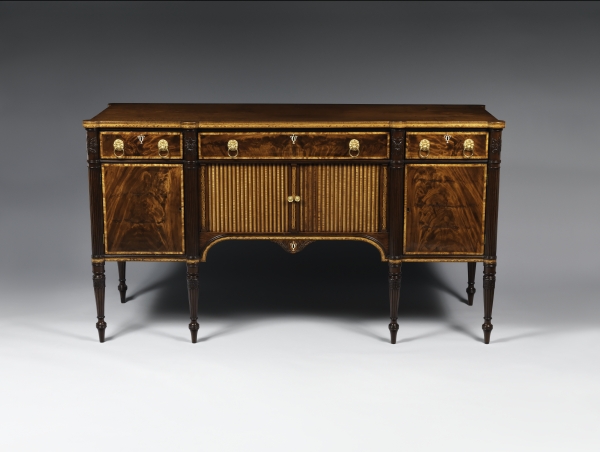
FIG. 9. Sideboard, attributed to Thomas Seymour, Boston, 1810–15. Mahogany, mahogany and curly maple veneers, birch, holly, soft maple, white pine, cherry; h 41⅞, w 73, d 263/16. Metropolitan Museum of Art; Gift of the family of Mr. and Mrs. Andrew Varick Stout, in their memory, 1965 (65.188.1).
CARVING
Lastly, there is the question of carving, the work of specialists for hire. Page Talbott lists more than a dozen carvers in Boston in the second decade of the nineteenth century, three of them neighbors of Benjamin Bass at 12 Orange Street: in 1820, Thomas Wightman (with four employees) at number 9, William Neville at number 15, and Clarke Parker at an undisclosed number. Of these, only Wightman’s name is familiar today. Thomas Seymour itemized Wightman’s charge for carving one of the Derby pieces in the 1809 bill, and he is routinely credited with the carving on all the pieces attributed to Seymour.30 Of significance for this study is that, according to Bass’s 1819 estate, Bass owed Wightman $26, presumably for carving work. All told, there is a good case for crediting him with the finely carved rosettes and capitals on the legs of Bass’s sideboard (see figs. 10, 11). The inspiration for these tightly controlled acanthus and waterleaf designs may be found in the illustrations in Thomas Sheraton’s The Cabinet-Maker and Upholsterer’s Drawing-Book (London, 1793)—Seymour’s own copy is at the Museum of Fine Arts, Boston—as well as, perhaps, in a local volume, Asher Benjamin’s American Builders Companion (Boston, 1806).31 The carving on the Soren sideboard (figs. 12, 13) is close to that of the Bass versions; some of the difference in their appearance today results from one having been refinished, the other not. The carving on the Stout sideboard (figs. 14, 15) is altogether different. The turner has relieved the space around the rosette so that it stands clear, and the articulation of the water leaves is much softer and less realistic. The method is like the one on the Seymour commode (fig. 16), but without any of the finesse in execution. Indeed, more than one carver’s hand was likely at work here.
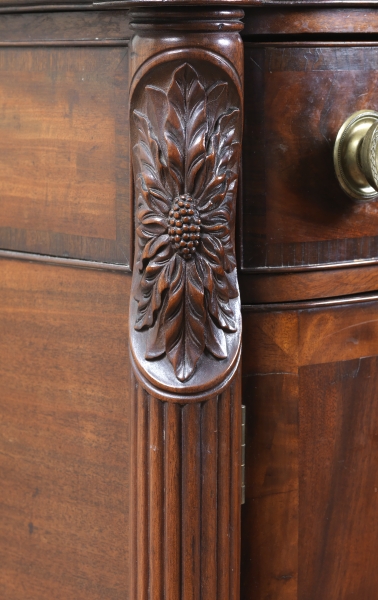
FIG. 10. A carved rosette on the sideboard in fig. 7.
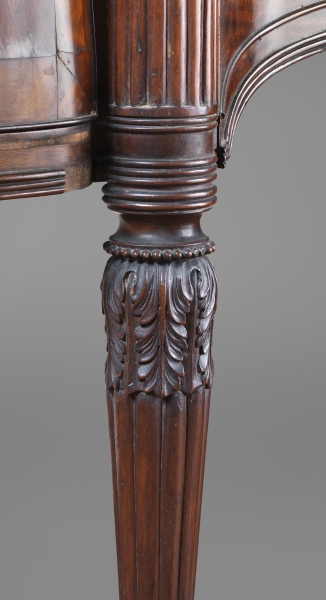
FIG. 11. A carved capital on the sideboard in fig. 7.
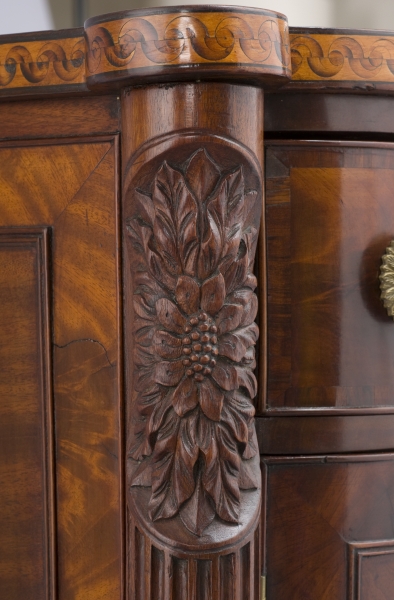
FIG. 12. A carved rosette on the sideboard in fig. 8.
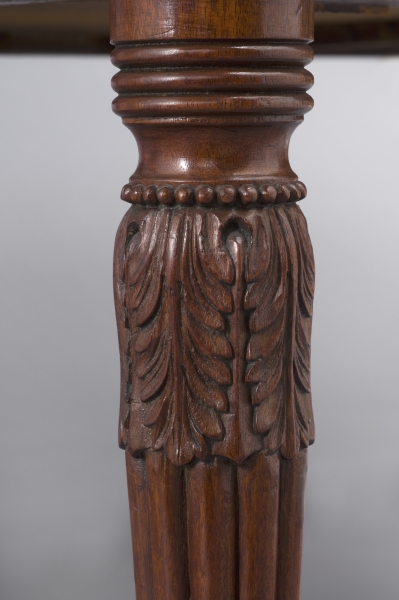
FIG. 13. A carved capital on the sideboard in fig. 8.
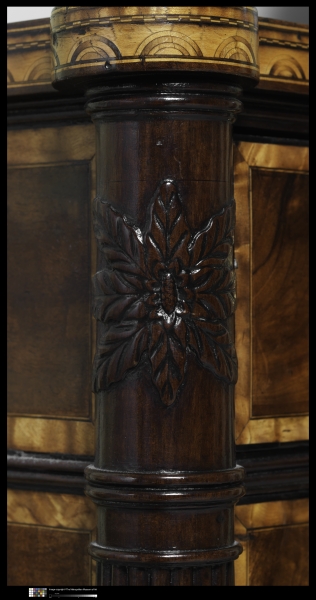
FIG. 14. A carved rosette on the sideboard in fig. 9.
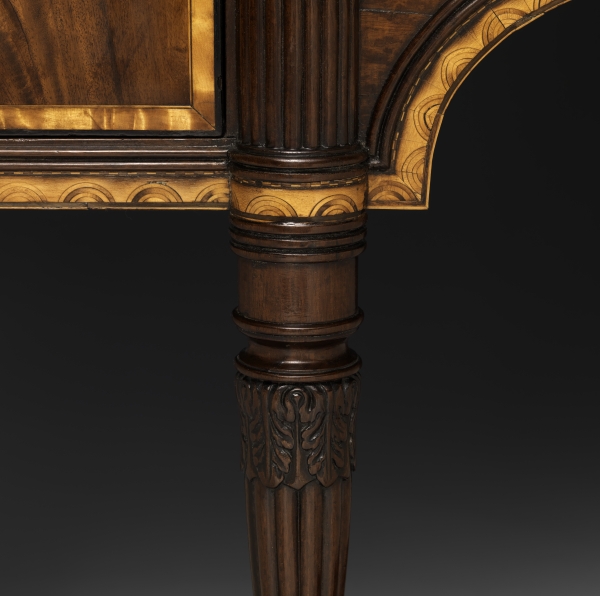
FIG. 15. A carved capital on the sideboard in fig. 9.
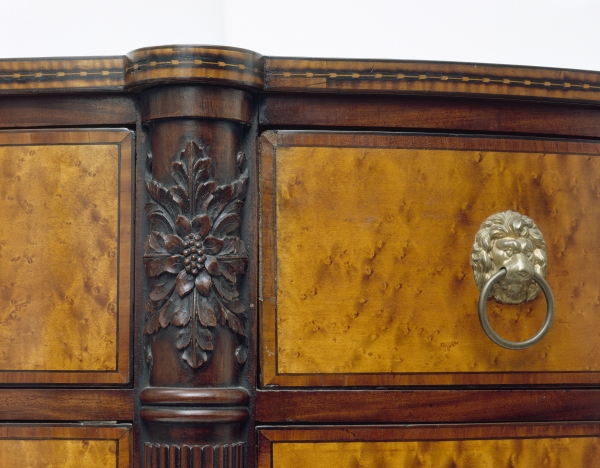
FIG. 16. Detail of the Derby family commode (seen in its entirety in fig. 1 as a semicircular chest of drawers thought to have been carved by Samuel McIntire) showing a rosette carved by Thomas Wightman (1759–1827) for Thomas Seymour in 1809. Museum of Fine Arts, Boston; The M. and M. Karolik Collection of Eighteenth-Century American Arts (23.19).
The “perplexing sideboard” that Homer Keyes first discussed in 1931 is now recognizable as part of a group of similar pieces associated with the shop of Benjamin Bass Jr., a hitherto shadowy contemporary of Thomas Seymour. Thanks to the chance discovery of Bass’s signature, a new window has been opened onto the complex landscape of Boston cabinetmakers of the early nineteenth century.
I am indebted to many people for help with this essay, beginning with Jane Nylander for first whetting my interest with a copy of Bass’s massive inventory. I owe particular thanks to Page Talbott and Robert Mussey for so generously sharing their unpublished archival researches on Bass, to Bard Center graduate student Alizzandra Baldenebro for a semester of excellent research work on the project, and to colleague Peter Kenny for many an astute observation.

1. Fiske Kimball, “The Furniture Carvings of Samuel McIntire,” appeared in Antiques in five installments between Nov. 1930 and Mar. 1931. See “Case Pieces,” Antiques 19, no. 3 (Mar. 1931): 207–10. Kimball’s monograph, Mr. Samuel McIntire, Carver: The Architect of Salem, was published by the Essex Institute, Salem, in 1940.
2. [Homer Eaton Keyes], “A Perplexing Sideboard,” in The Editor’s Attic, Antiques 19, no. 3 (Mar. 1931): 181–82. For the Soren sideboard, see William Voss Elder III and Jayne E. Stokes, American Furniture, 1680–1880, from the Collection of the Baltimore Museum of Art (Baltimore: Baltimore Museum of Art, 1987), 152–54, cat. no. 116.
3. Mabel M. Swan, “John Seymour & Son, Cabinetmakers,” Antiques 32, no. 4 (Oct. 1937): 176–79. See also Vernon C. Stoneman, John and Thomas Seymour, Cabinetmakers in Boston, 1794–1816 (Boston: Special Publications, 1959); Vernon C. Stoneman, A Supplement to John and Thomas Seymour, Cabinetmakers in Boston, 1794–1816 (Boston: Special Publications, 1965), and Robert D. Mussey Jr., The Furniture Masterworks of John and Thomas Seymour (Salem, Mass.: Peabody Essex Museum, 2003), now the standard reference.
4. Homer Eaton Keyes, “A Note on the Seymour Manner,” Antiques 32, no. 4 (Oct. 1937): 179–80.
5. Edwin J. Hipkiss, “A Seymour Bill Discovered,” Antiques 51, no. 4 (Apr. 1947): 244–45. That the “Large Mahogany Comode . . . $80” refers to the Derby commode is proven by the additional charge of $10 on behalf of John Ritto Penniman for painting the shells found on its top.
6. Fiske Kimball, Director, Pennsylvania Museum of Art, to Miss Lucretia S. Heckscher, Belrose Lane, Radnor, Pa., June 19, 1934. The letter is stored in the right-hand bottle drawer of the signed sideboard.
7. The Welds lived on High St. near Fort Hill, 1800–1806; at 67 Newbury St., 1806–7; in Cambridge St., 1809–13; in Chardon Lane, 1816; in Griffin Lane or Pearl St. Extended, 1818–20; and in Pearl St., 1821. This information was kindly culled from the issues of the Boston City Directory by Alizzandra Baldenebro.
8. Boston Commercial Gazette, May 9, 1822. The building was demolished in 1851.
9. The sideboard then descended in the female line to Abigail Perkins Weld (1799–1886); Lucretia Ledyard Stevens (1830–1907); and Lucretia Stevens Heckscher (1862–1949). It had pride of place in this last’s dining room at 115 Beacon St., Boston, from 1912 to 1921 and appears in a photograph album documenting the house’s interiors in that era. She moved to Radnor, Pa., in 1921, and it was there in 1934 that Fiske Kimball first encountered the sideboard.
10. E. Page Talbott, “The Furniture Industry in Boston, 1810–1835” (master’s thesis, University of Delaware, 1974); for Bass, see 50–51. Talbott’s Boston Directory research is summarized in “The Furniture Trade in Boston, 1810–1835,” Antiques 141, no. 5 (May 1992): 842–55 (for Bass, see 846). The first modern mention of Bass as cabinetmaker is in Myrna Kaye, “List of Boston Furniture Craftsmen,” in Boston Furniture of the Eighteenth Century: A Conference Held by the Colonial Society of Massachusetts, 11 and 12 May 1972, ed. Walter Muir Whitehill, Jonathan L. Fairbanks, and Brock Jobe, Publications of the Colonial Society of Massachusetts, vol. 48 (Boston: Colonial Society of Massachusetts, 1974), 271. See also Anne Rogers Haley, “Boston Cabinetmakers and Allied Craftsmen, 1780–1799,” Antiques 149, no. 5 (May 1996): 762.
11. I have had the particular benefit of Robert Mussey’s researches relating to Benjamin Bass Jr., including extracts from the Boston Tax Books, Ward 12, 1798–1820 (Boston Public Library); Suffolk County Court of Common Pleas; the Boston City Directory; and the Columbian Centinel and Boston Patriot newspapers.
12. For Bass family genealogy, see Charissa Taylor Bass, comp., Descendants of Deacon Samuel & Ann Bass (Freeport, Ill.: [Wagner Print.], 1940).
13. From the Columbian Centinel, Sept. 1 and Oct. 1, 1800.
14. The number of journeymen in residence with Bass in a given year generally ranged from two to four during 1800–1807 and 1815–19, and five to six between 1808 and 1815. Exceptionally, he housed eleven different journeymen in 1809, ten in 1817.
15. Bass and Barker v. Burns et al., Extended Record Book (Jan. 1815), case no. 289, folio 90, Massachusetts Inferior Court of Common Pleas (Suffolk County), Massachusetts State Archives, Boston. My thanks to Thomas Michie for this reference.
16. Among a group of furniture receipts acquired by Historic New England in Aug. 2012. See Robert D. Mussey Jr., “Dowries for Two Daughters,” Historic New England 13, no. 3 (Winter/Spring 2013): 34.
17. Said to be one of a pair of card tables purchased from Bass and Barker by Francis A. Foxcroft, July 16, 1816; sold at Northeast Auctions, May 17, 1998, lot 178 (illus.).
18. All legal aspects of Bass’s estate are recorded in Suffolk County Probate Records, docket no. 25926. The inventory is transcribed in 117: 432–51.
19. The four references to “sett tools” (lots 675–78) and five to “Bench and holdfast” (lots 679–83) in the Bass inventory suggest the number of his employees at a given time. Compare with the numbers of journeymen in residence with Bass over the years (see n. 14).
20. My thanks to Page Talbott for sharing her lists of Bass’s creditors and debtors.
21. Robert M. Peck, in consultation with his colleagues at the Academy of Natural Sciences of Drexel University, Philadelphia, assures me that nothing in nature looks like this carved motif.
22. For identical ivory inserts, in addition to the Soren sideboard, see Mussey, John and Thomas Seymour, cat. nos. 64 and 65, dressing chests with mirrors at the White House and at Winterthur Museum.
23. For Hands and Jenkins, see Donald L. Fennimore, Metalwork in Early America: Copper and Its Alloys from the Winterthur Collection (Winterthur, Del.: Henry Francis du Pont Winterthur Museum, 1996), 382, cat. no. 263. Although the Hands and Jenkins partnership ended before the sideboard was made, it is reasonable to assume that their stock of marked hardware took considerable time to be distributed and put to use.
24. For related inlay patterns, see Mussey, John and Thomas Seymour, cat. nos. 42–43, 46 (sideboards) and cat. nos. 145–47 (tall clocks).
25. Mussey correctly characterized the Soren sideboard as in a distinctive late Sheraton style and makes mention of at least eight related examples; see Mussey, John and Thomas Seymour, 227, cat. no. 46.
26. See Stoneman, Seymour, fig. 84; Stoneman, Seymour Supplement, fig. 23 (now Toledo Museum of Art); American Antiques from Israel Sack Collection, 10 vols. (Washington, D.C.: Highland House, 1969–92), 2:488; Bernard & S. Dean Levy advertisement, Antiques 109, no. 5 (May 1976): 834.
27. For the Peabody Essex Museum example, see Mussey, John and Thomas Seymour, cat. no. 41; for the later examples, see cat. nos. 47, 48.
28. See Page Talbott, “Boston Empire Furniture. Part I,” Antiques 107, no. 5 (May 1975): 878–87; and Talbott, “Boston Empire Furniture, Part II,” Antiques 109, no. 5 (May 1976): 1004–13. See also the essay by Robert D. Mussey Jr. and Clark Pearce in this volume.
29. Columbian Centinel, Dec. 24, 1817.
30. “Paid Thos Whitmans Bill for Carving Legs & Orniment Top for do [1 Elegant Dressing Table—$60]—$12”; see n. 5.
31. Thomas Sheraton, The Cabinet-Maker and Upholsterer’s Drawing-Book (London, 1793), pl. 29 (A Sideboard Table). In An Accompaniment to the Cabinet-Maker and Upholsterer’s Drawing-Book (London, 1794), pl. 2 (Chair Legs), pl. 5 (Cornices with Ornamental Friezes), pl. 11 (Ornament for a Tablet & Various Leaves). Asher Benjamin, American Builder’s Companion (Boston: Etheridge and Bliss, 1806), pl. 26.
